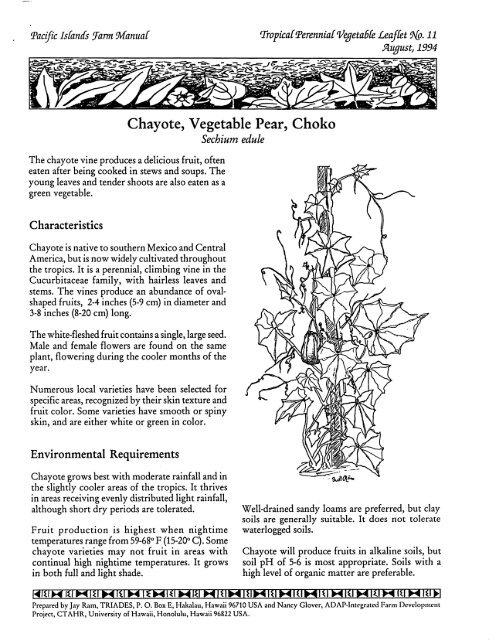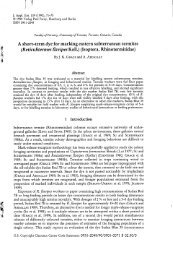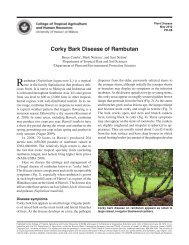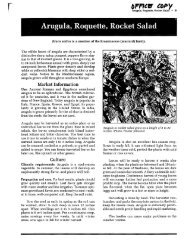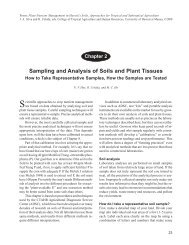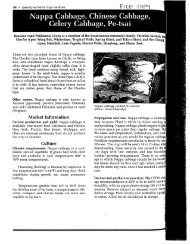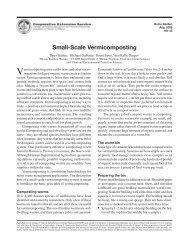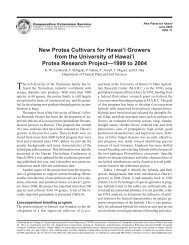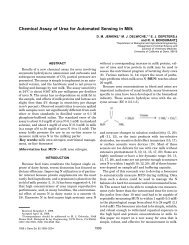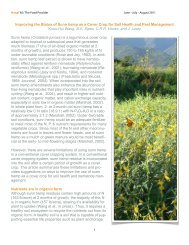Chayote, Vegetable Pear, Choko - ctahr - University of Hawaii
Chayote, Vegetable Pear, Choko - ctahr - University of Hawaii
Chayote, Vegetable Pear, Choko - ctahr - University of Hawaii
You also want an ePaper? Increase the reach of your titles
YUMPU automatically turns print PDFs into web optimized ePapers that Google loves.
Pacific Islands farm 'Manual Tropical Perennial-<strong>Vegetable</strong>. Leaflet 9{o. 11<br />
The chayote vine produces a delicious fruit, <strong>of</strong>ten<br />
eaten after being cooked in stews and soups. The<br />
young leaves and tender shoots are also eaten as a<br />
green vegetable.<br />
Characteristics<br />
<strong>Chayote</strong> is native to southern Mexico and Central<br />
America, but is now widely cultivated throughout<br />
the tropics. It is a perennial, climbing vine in the<br />
Cucurbitaceae family, with hairless leaves and<br />
stems. The vines produce an abundance <strong>of</strong> ovalshaped<br />
fruits, 2-4 inches (5-9 cm) in diameter and<br />
3-8 inches (8-20 cm) long.<br />
<strong>Chayote</strong>, <strong>Vegetable</strong> <strong>Pear</strong>, <strong>Choko</strong><br />
The white-fleshed fruit contains a single, large seed.<br />
Male and female flowers are found on the same<br />
plant, flowering during the cooler months <strong>of</strong> the<br />
year.<br />
Numerous local varieties have been selected for<br />
specific areas, recognized by their skin texture and<br />
fruit color. Some varieties have smooth or spiny<br />
skin, and are either white or green in color.<br />
Environmental Requirements<br />
<strong>Chayote</strong> grows best with moderate rainfall and in<br />
the slightly cooler areas <strong>of</strong> the tropics. It thrives<br />
in areas receiving evenly distributed light rainfall,<br />
although short dry periods are tolerated.<br />
Fruit production is highest when nightime<br />
temperatures range from 59-68° F (15-20° C). Some<br />
chayote varieties may not fruit in areas with<br />
continual high nightime temperatures. It grows<br />
in both full and light shade.<br />
Sechium edule<br />
August, 1994<br />
Well-drained sandy loams are preferred, but clay<br />
soils are generally suitable. It does not tolerate<br />
waterlogged soils.<br />
<strong>Chayote</strong> will produce fruits in alkaline soils, but<br />
soil pH <strong>of</strong> 5-6 is most appropriate. Soils with a<br />
high level <strong>of</strong> organic matter are preferable.<br />
Prepared by Jay Ram, TRIADES, P. O. Box E, Hakalau, <strong>Hawaii</strong> 96710 USA and Nancy Glover, ADAP-Integrated Farm Development<br />
Project, CTAHR, <strong>University</strong> <strong>of</strong> <strong>Hawaii</strong>, Honolulu, <strong>Hawaii</strong> 96822 USA.<br />
\i\ >\
Tadfic Islands Jam Manual Tropical!Perennial1tyeta6(e Leaflet ftyp. 11, August 1994<br />
HillM 111 M)*l . Mltl M1SMKI MM MUIMWMKi MUlMtti Mill M1*1 M Ki IHKl M<br />
Uses and Preparation<br />
<strong>Chayote</strong> is most commonly cultivated for its edible<br />
fruit. Generally the whole fruit is eaten, seed and<br />
all.<br />
<strong>Chayote</strong> is peeled, cut in cubes, and added to soups<br />
and stews. It can also be baked and eaten like<br />
squash, flavored in a variety <strong>of</strong> ways to suit local<br />
customs.<br />
The mature seed is s<strong>of</strong>t and has a nutty flavor when<br />
boiled. The roots are edible as well, and can be<br />
eaten raw, boiled, roasted or fried, tasting similiar<br />
to a yam.<br />
The main root is carefully harvested after two<br />
years without disturbing the small roots, leaving<br />
the plant intact.<br />
The young leaves and tender shoots are<br />
nutritionally quite valuable. The climbing tendrils<br />
should be removed from the shoots, as they can<br />
be fibrous.<br />
The young leaves and shoots are an appetizing<br />
cooked green vegetable, and <strong>of</strong>ten added to soups<br />
and stews.<br />
Nutritional Value<br />
Everyone in the family should eat some green<br />
leaves everyday. Children, pregnant women and<br />
nursing mothers especially need the protein,<br />
vitamins and minerals found in green leaves.<br />
For many children, green leaves are the sole source<br />
<strong>of</strong> vitamin A, an essential vitamin in preventing<br />
blindness.<br />
Green leaves also contain phytochemicals,<br />
thousands <strong>of</strong> chemical tongue twisters like<br />
sulforaphane, genistein and indole-3-carbinol, that<br />
are the new frontier in cancer-prevention research.<br />
Serving a variety <strong>of</strong> green leaves will keep the<br />
whole family healthy.<br />
CHAYOTE LEAVES:<br />
Serving Size: 1/2 cup (100 g) fresh leaves<br />
Protein<br />
Calcium<br />
Iron<br />
Vitamin A<br />
Vitamin C<br />
Actual<br />
Quantity<br />
4 g<br />
62 mg<br />
1.4 mg<br />
5045 IU<br />
24 mg<br />
% Daily Value<br />
USDA, 2000 Calorie Diet<br />
8 %<br />
6.2 %<br />
7.7 %<br />
101 %<br />
40 %<br />
Source: Tindall, H.D. 1983. <strong>Vegetable</strong>s in the Tropics<br />
CHAYOTE FRUIT:<br />
Serving Size: 1/2 cup (100 g) fresh leaves<br />
Protein<br />
Calcium<br />
Iron<br />
Vitamin A<br />
Vitamin C<br />
Actual<br />
Quantity<br />
0.7 g<br />
17 mg<br />
0.4 mg<br />
50 IU<br />
14 mg<br />
% Daily Value<br />
USDA, 2000 Calorie Diet<br />
1.4 %<br />
1.7 %<br />
2.2 %<br />
1 %<br />
23.3 %<br />
Source: Tindall, H.D. 1983. <strong>Vegetable</strong>s in the Tropics<br />
Propagation<br />
<strong>Chayote</strong> is propagated by planting the mature fruit<br />
or by rooted stem cuttings.<br />
• Mature Fruits<br />
Mature fruits <strong>of</strong> chayote can be either planted<br />
whole to a depth <strong>of</strong> two-thirds <strong>of</strong> its length with<br />
the widest end downwards or planted horizontally<br />
with one-fourth <strong>of</strong> the fruit remaining aboveground.<br />
iskiki ma nmn mum Mm»«m mrix \i\ ►* ki
Tacific Islands Jam Manual TropicalTerennial <strong>Vegetable</strong> Leaflet jyb. 11, August 1994<br />
Mature fruits <strong>of</strong> chayote can be planted either vertically or<br />
horizontally.<br />
<strong>Chayote</strong> should be planted along a trellis, or other<br />
suitable structure, that is 5-6 feet in height (1.5-2<br />
m). Plants should be spaced 25-30 inches (60 - 75<br />
cm) apart.<br />
• Stem Cuttings<br />
If fruits are not available, stem cuttings 6 - 8 inches<br />
(15 - 20 cm) in length with 2-4 nodes can be<br />
prepared from mature stems.<br />
Remove all leaves and plant slanting or<br />
horizontally.<br />
The cuttings should be planted in containers,<br />
placed in the shade, and kept moist. Containergrown<br />
cuttings are ready to transplant after 1 - 2<br />
months, when a good root system is developed.<br />
Establishment<br />
Planting is best done at the beginning <strong>of</strong> the rainy<br />
season to ensure high survival and good growth.<br />
Adding compost or green manure in the planting<br />
hole will provide needed nutrients for good<br />
establishment.<br />
Mulch placed around the planting area will reduce<br />
soil moisture loss and help to control weeds.<br />
Trellis Structures<br />
<strong>Chayote</strong> is a vine and must have a trellis structure<br />
<strong>of</strong> some sort to grow on. Trellis structures can be<br />
made <strong>of</strong> permanent materials (fencepost and wire)<br />
or from materials that are periodically replaced,<br />
such as bamboo or tree poles. The height <strong>of</strong> the<br />
trellis structure should be no more than 6 feet (2<br />
m) for ease <strong>of</strong> harvesting.<br />
The form <strong>of</strong> the trellis can be made to suit the<br />
needs <strong>of</strong> the household. For example, a simple<br />
dome can be constructed out <strong>of</strong> bent poles with<br />
the vines allowed to cover the dome, creating a<br />
cool, and shady rest area during the heat <strong>of</strong> the<br />
day.<br />
In the same manner, poles can be strung between<br />
two buildings or other points <strong>of</strong> attachment and<br />
the vines allowed to grow upon them, providing<br />
shade and vegetables at the same time.<br />
<strong>Chayote</strong> planted on fences is quite attractive.<br />
Fences <strong>of</strong> chayote can be used to create privacy or<br />
to separate different areas <strong>of</strong> the home garden.<br />
<strong>Chayote</strong> planted on or near live trees may invade<br />
and smother the trees.<br />
Harvest and Storage<br />
<strong>Chayote</strong> fruits are harvested 4 months after<br />
planting, approximately 30 days after flowering.<br />
The fruits transport well for up to 6 weeks at 50"<br />
F (10° C) and 90% relative humidity. They can be<br />
stored for longer periods when buried in the dry<br />
sand. Seeds cannot be dried.<br />
Pests and Diseases<br />
Few serious pest and disease problems have been<br />
reported for chayote. In India, scale and aphids<br />
are common pests. Potential pests and diseases <strong>of</strong><br />
chayote include powdery mildew and the striped<br />
and spotted cucumber beetle. Nematode resistance<br />
is low.
Tacific lsiands 'farm MamiaC 'TropicaiTerenniaCVegetaBk Leaflet 9^g. 11, August 1994<br />
Further Reading<br />
Bailey, John M. 1992. The Leaves We Eat. SPC Handbook<br />
No. 31. South Pacific Commission, Noumea, Caledonia.<br />
Oomen, H.A.P.C. and G.J.H. Grubben. 1978. Tropical Leaf<br />
<strong>Vegetable</strong>s in Human Nutrition. Communication 69,<br />
Department <strong>of</strong> Agriculture Research, Royal Tropical<br />
Institute, Amsterdam.<br />
Tindall, H.D. 1983. <strong>Vegetable</strong>s in the Tropics. Macmillan<br />
Education Ltd., London.<br />
Sources <strong>of</strong> Planting Material<br />
Tropical Rural and Island/Atoll Development<br />
Experimental Station (TRIADES)<br />
P.O. Box E<br />
Hakalau, <strong>Hawaii</strong> 96710 USA<br />
Telephone/Fax: 808-963-6823<br />
This publication was assumed to be correct at the date <strong>of</strong> its issue, but it may no longer represent the<br />
most up-to-date information on its subject. In particular, if this publication contains information about<br />
pesticide uses, the products mentioned may not currently be licensed for sale in <strong>Hawaii</strong> or<br />
labeled for the uses described.<br />
This leaflet may be reproduced for educational purposes.<br />
When doing so, please acknowledge the ADAP Project.<br />
A D A P<br />
PROJECT Purfk Land Grant Programs<br />
A publication <strong>of</strong> the ADAP-Integratcd Farm Development Project, CTAHR, <strong>University</strong> <strong>of</strong> <strong>Hawaii</strong>, Honolulu, HI 96822 USA


